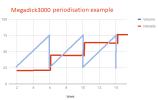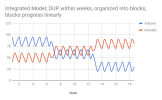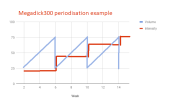Megadick3000
Member
Dig in boys. Too much volume? Not enough volume? Too much intensity? Not enough frequency? Too much frequency?
Notes:
+ symbol means supersetted with, as in no rest time between exercises
Last 2 sets of every exercise are performed to total failure, prior sets are performed to within 1-2 reps of failure
I dont really do warm up sets (i have sinned)
I dont workout with a spotter
Last set of most exercises are drop sets beyond failure (where applicable)
Im not on any gear and have not ran a cycle in over 4 years
Ab work gets thrown in randomly
Not currently deadlifting due to prior injuries. Squatting on leg days. Not dipping due to it giving me wrist and elbow issues lately.
Workout A (back, biceps):
Chin ups (AMRAP, 3 sets) + Rackpulls (6-8 reps, 3 sets)
DB standing bicep curls (8-10 reps, 4 sets) + barbell shrugs (8-10 reps, 4 sets)
T-bar standing cable bicep curls (8-10 reps, 4 sets) + V-bar seated cable rows (10-12 reps, 4 sets)
DB crossbody hammer curls (8-10 reps, 4 sets) + lat pulldowns (8-10 reps, 4 sets)
Workout B (chest, triceps):
Flat BB bench press (8-10 reps, 5 sets)
Guillotine BB bench press (8-10 reps, 5 sets)
Close grip BB bench press (8-10 reps, 4 sets) + Pec Dec Flyes (8-10 reps, 4 sets)
T-bar cable pushdowns (8-10 reps, 4 sets)
DB overhead Tricep extensions (8-10 reps, 2 sets)
DB Tricep kickbacks (8-10 reps, 3 sets)
Workout C (legs, shoulders):
BB back squats (8-10 reps, 3 sets)
Seated overhead BB press (8-10 reps, 4 sets) + leg press (8-10 reps, 2 sets at shoulder width, 2 sets at max width, 2 sets feet together) + leg extensions (8-10 reps, 6 sets)
DB or Cable side lateral raises (8-10 reps, 4 sets) + DB front raises (8-10 reps, 4 sets)
Incline bench laying reverse DB flyes (8-10 reps, 4 sets)
Workouts alternate for 5 days a week like so:
Monday “A”
Tuesday “B”
Wednesday “C”
Thursday “A”
Friday “B”
Saturday/sunday rest
Monday “C”... etc.
Sometimes rest days get broken up through the week. It depends on my schedule and also how im feeling in general. Its not always two days of rest in a row, sometimes its rest day after an ABC run.
On the V-bar cable rows reps are higher because i am maxed on the weight stack. Infact to totally fail i usually need upwards of 15 reps. To be honest i should probably switch to BB rows as i cannot add anymore weight to the exercise.
Over time i add a set to everything, then another set later on, then deload back to 4 sets with hopefully higher weight. I try to increase weight as often as i can but my joints tend to hold me back.
Sometimes i feel like i am over training. My recovery seems shit compared to past years of my life, im just getting fucking old i think. Keep in mind im off everything, AAS and GH. What do you guys think? I dont feel like im progressing, 2 years of COVID lockdowns peeled a lot of weight off me, i rapidly put back the majority of it within 2 months but now im stalling out. What would you change and why?
Notes:
+ symbol means supersetted with, as in no rest time between exercises
Last 2 sets of every exercise are performed to total failure, prior sets are performed to within 1-2 reps of failure
I dont really do warm up sets (i have sinned)
I dont workout with a spotter
Last set of most exercises are drop sets beyond failure (where applicable)
Im not on any gear and have not ran a cycle in over 4 years
Ab work gets thrown in randomly
Not currently deadlifting due to prior injuries. Squatting on leg days. Not dipping due to it giving me wrist and elbow issues lately.
Workout A (back, biceps):
Chin ups (AMRAP, 3 sets) + Rackpulls (6-8 reps, 3 sets)
DB standing bicep curls (8-10 reps, 4 sets) + barbell shrugs (8-10 reps, 4 sets)
T-bar standing cable bicep curls (8-10 reps, 4 sets) + V-bar seated cable rows (10-12 reps, 4 sets)
DB crossbody hammer curls (8-10 reps, 4 sets) + lat pulldowns (8-10 reps, 4 sets)
Workout B (chest, triceps):
Flat BB bench press (8-10 reps, 5 sets)
Guillotine BB bench press (8-10 reps, 5 sets)
Close grip BB bench press (8-10 reps, 4 sets) + Pec Dec Flyes (8-10 reps, 4 sets)
T-bar cable pushdowns (8-10 reps, 4 sets)
DB overhead Tricep extensions (8-10 reps, 2 sets)
DB Tricep kickbacks (8-10 reps, 3 sets)
Workout C (legs, shoulders):
BB back squats (8-10 reps, 3 sets)
Seated overhead BB press (8-10 reps, 4 sets) + leg press (8-10 reps, 2 sets at shoulder width, 2 sets at max width, 2 sets feet together) + leg extensions (8-10 reps, 6 sets)
DB or Cable side lateral raises (8-10 reps, 4 sets) + DB front raises (8-10 reps, 4 sets)
Incline bench laying reverse DB flyes (8-10 reps, 4 sets)
Workouts alternate for 5 days a week like so:
Monday “A”
Tuesday “B”
Wednesday “C”
Thursday “A”
Friday “B”
Saturday/sunday rest
Monday “C”... etc.
Sometimes rest days get broken up through the week. It depends on my schedule and also how im feeling in general. Its not always two days of rest in a row, sometimes its rest day after an ABC run.
On the V-bar cable rows reps are higher because i am maxed on the weight stack. Infact to totally fail i usually need upwards of 15 reps. To be honest i should probably switch to BB rows as i cannot add anymore weight to the exercise.
Over time i add a set to everything, then another set later on, then deload back to 4 sets with hopefully higher weight. I try to increase weight as often as i can but my joints tend to hold me back.
Sometimes i feel like i am over training. My recovery seems shit compared to past years of my life, im just getting fucking old i think. Keep in mind im off everything, AAS and GH. What do you guys think? I dont feel like im progressing, 2 years of COVID lockdowns peeled a lot of weight off me, i rapidly put back the majority of it within 2 months but now im stalling out. What would you change and why?






